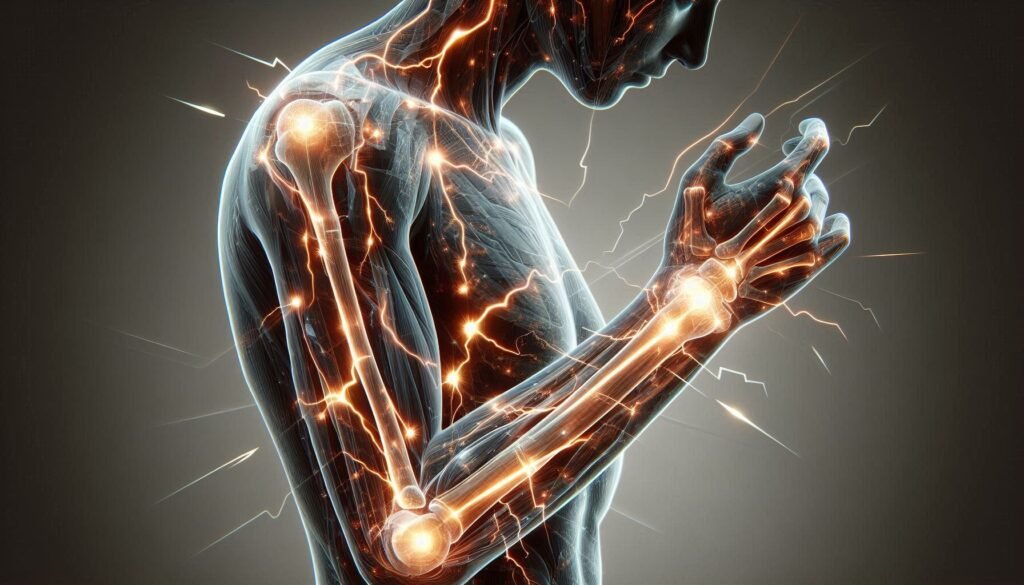Traumatic injuries can leave lasting physical and emotional scars. Among the various effects these injuries can have, paresthesia is a common yet often overlooked symptom. This tingling or numb sensation can arise unexpectedly after an incident, leading to confusion and concern.
Understanding the connection between traumatic injuries and the onset of paresthesia is essential for anyone who has experienced such events. Whether you’ve suffered from a sports injury, car accident, or even minor trauma, recognizing how it may affect your nerves could be crucial for your recovery journey. In this article, we’ll explore the types of injuries that can trigger these sensations and what you need to know about their implications on your health.

Types of Traumatic Injuries That Can Lead to Paresthesia
Traumatic injuries encompass a wide range of incidents that can affect the body. Common types include fractures, dislocations, and soft tissue damage. Each type carries its own risk for nerve involvement, potentially leading to paresthesia.
Sports-related injuries often result in sprains or strains that can compress nerves. A simple twist or fall may not seem serious at first but could have lasting impacts on nerve function. Such injuries require awareness for early detection of symptoms like tingling or numbness.
Car accidents frequently lead to whiplash and spinal injuries. The sudden impact can stretch or tear nerves in the neck and back regions, causing widespread sensations throughout the body. These cases emphasize the importance of seeking medical evaluation after any collision.
Even minor traumas, such as cuts from sharp objects, can lead to localized paresthesia if they damage peripheral nerves. Understanding how various traumatic events relate to these sensations is vital for effective treatment and recovery strategies.
Nerve Damage in Traumatic Injuries: Mechanisms and Effects
Nerve damage often occurs during traumatic injuries, leading to various symptoms including paresthesia. This condition can arise from direct impact, stretch, or compression of nerve tissues. Such mechanical insults disrupt the normal structure and function of nerves.
When a nerve is injured, it can undergo several pathological changes. The axon may degenerate, disrupting signal transmission between the brain and affected body parts. Inflammation around the injury site also plays a significant role in exacerbating pain and sensory disturbances.
Different types of trauma result in varying degrees of nerve damage. For instance, minor injuries might only cause temporary impairment, while severe impacts could lead to permanent dysfunction or loss of sensation altogether. Understanding these mechanisms helps identify potential treatment options.
The effects of nerve damage extend beyond physical sensations; they can influence emotional well-being too. Individuals experiencing persistent paresthesia may face psychological challenges that stem from their altered bodily experiences and limitations in daily activities.
Spinal Cord Injuries: A Major Cause of Widespread Paresthesia
Spinal cord injuries can have profound effects on the nervous system, leading to widespread paresthesia. These injuries often occur due to trauma from accidents, falls, or violent impacts. When the spinal cord is damaged, it disrupts communication between the brain and various body parts.
The severity of paresthesia depends on the injury’s location along the spinal cord. Injuries at higher levels might cause symptoms in larger areas of the body compared to those lower down. For instance, a cervical spine injury may result in sensations like tingling or numbness across arms and legs.
Inflammation around the injured area can also contribute to nerve irritation. This inflammation can exacerbate feelings of pins and needles that many experience following an injury. In some cases, this sensation becomes chronic if not properly managed.
Understanding these mechanisms helps healthcare providers tailor treatment approaches for individuals experiencing post-traumatic paresthesia from spinal cord injuries. Early intervention plays a crucial role in addressing symptoms effectively while supporting recovery efforts.
Peripheral Nerve Injuries: From Minor Cuts to Major Traumas
Peripheral nerve injuries can occur from various incidents, ranging from minor cuts to severe traumas. These nerves are critical for transmitting signals between the central nervous system and the rest of the body. Even a small injury may disrupt normal function, leading to symptoms like tingling or numbness.
More significant trauma, such as fractures or dislocations, often results in more profound nerve damage. This can happen when bones break and compress nearby nerves or when they are pulled apart during an accident. Such injuries can lead to extensive paresthesia and loss of motor control.
In cases where there is laceration, surgical intervention might be necessary to repair damaged nerves effectively. The severity of these injuries influences recovery time and rehabilitation strategies.
Understanding how different types of peripheral nerve injuries affect sensation is crucial for timely treatment. Early medical evaluation plays a key role in preventing long-term complications associated with traumatic injuries.
Crush Injuries and Compartment Syndrome: Impact on Nerve Function
Crush injuries occur when a body part is subjected to significant force, often resulting in severe tissue damage. This type of injury can lead to immediate and sometimes lasting complications, particularly affecting nerve function. The pressure from the crushing force can harm not only muscles but also the surrounding nerves.
Compartment syndrome often accompanies crush injuries. It arises when swelling within a closed muscle compartment increases pressure, leading to reduced blood flow and oxygen supply. As pressure builds up, it compromises nerve health and functionality.
Patients may experience symptoms such as numbness, tingling, or weakness in the affected area due to this disruption in nerve signaling. If untreated, compartment syndrome can result in permanent nerve damage or even loss of limb function.
Timely medical intervention is crucial for managing these injuries effectively. Early recognition and treatment help alleviate symptoms and minimize long-term impacts on nerve function after experiencing a crush injury.
Burns and Frostbite: Thermal Injuries Causing Paresthesia
Thermal injuries, such as burns and frostbite, can significantly disrupt nerve function. When skin is exposed to extreme heat or cold, it can lead to a range of sensory disturbances, including paresthesia. This sensation often manifests as tingling or numbness in the affected areas.
Burns damage not only the outer layer of skin but may also penetrate deeper tissues. The nerves within these layers become inflamed or destroyed due to thermal exposure. Consequently, individuals may experience persistent sensations long after the initial injury has healed.
Frostbite occurs when tissue freezes due to prolonged exposure to cold temperatures. As ice crystals form within cells, they cause cellular damage and disrupt blood flow. Nerve endings can be severely impacted, resulting in tingling sensations that may persist even after rewarming.
Both conditions underscore how critical timely treatment is for minimizing nerve damage and associated symptoms like paresthesia. Proper wound care and medical intervention play vital roles in recovery from these traumatic injuries.
Post-Traumatic Paresthesia: Immediate vs. Delayed Onset
Post-traumatic paresthesia refers to abnormal sensations like tingling, numbness, or a “pins and needles” feeling that can occur after an injury. The onset of these symptoms may vary significantly between individuals. For some, paresthesia is immediate, appearing right after the trauma.
This immediate response often indicates nerve involvement at or near the site of injury. It can signal direct damage to nerves or compression due to swelling. In such cases, timely medical intervention is crucial for minimizing long-term effects.
Delayed onset paresthesia occurs hours, days, or even weeks post-injury. This type might arise from secondary complications like inflammation or scarring affecting nerve pathways over time. Individuals may not connect their symptoms to the initial trauma.
Both types highlight different underlying mechanisms and potential severity in terms of nerve damage. Understanding these distinctions aids healthcare providers in tailoring appropriate treatments for affected patients.
Diagnosing Trauma-Induced Paresthesia: Medical Evaluation Process
Diagnosing trauma-induced paresthesia begins with a thorough medical history. Physicians will ask about the specific traumatic event, symptoms experienced, and their duration. This information helps establish a baseline for further investigation.
Next, a physical examination is conducted to assess sensation and motor function in the affected areas. Doctors may perform specific tests to evaluate reflexes and nerve responses. Observations during this phase can pinpoint nerve involvement or damage extent.
Diagnostic imaging plays an essential role as well. Techniques like MRI or CT scans reveal structural issues that could contribute to paresthesia, such as herniated discs or fractures pressing on nerves.
Electrophysiological studies are often used for deeper insights into nerve function. Nerve conduction studies measure how fast electrical impulses travel through nerves, while electromyography assesses muscle response to stimulation. Together, these evaluations create a comprehensive picture of the underlying issues related to trauma-induced paresthesia.
Treatment and Rehabilitation for Injury-Related Nerve Symptoms
Treatment for injury-related nerve symptoms often begins with a thorough evaluation by a healthcare professional. This assessment helps identify the specific nerves affected and determines the best course of action. Early intervention can reduce complications, so seeking medical help promptly is crucial.
Physical therapy plays a vital role in rehabilitation. Therapists design personalized exercise programs to improve strength and flexibility while promoting proper movement patterns. These exercises can alleviate discomfort and enhance overall functionality.
Medications may also be prescribed to manage pain or inflammation. Non-steroidal anti-inflammatory drugs (NSAIDs) are commonly used, but in severe cases, corticosteroids or anticonvulsants might be recommended to address more complex nerve issues.
In some instances, surgical interventions may become necessary if conservative treatments fail. Surgery could involve decompression of nerves or repairing damaged tissues directly. Each treatment plan should focus on restoring mobility and minimizing persistent paresthesia effects throughout recovery.
Long-Term Prognosis: Recovery and Adaptation After Traumatic Paresthesia
Long-term prognosis for individuals experiencing traumatic injuries that lead to paresthesia can vary widely based on several factors. Recovery largely depends on the severity of nerve damage, the type of injury sustained, and how quickly treatment is initiated. Some patients may experience complete resolution of symptoms over time, especially if the underlying cause is addressed promptly.
For others, particularly those with significant nerve compression or severe trauma, adaptation becomes crucial. Engaging in physical therapy can enhance recovery by improving strength and flexibility around affected areas. Occupational therapy may assist individuals in regaining daily functional skills.
It’s also important to monitor any changes in symptoms closely. Persistent or worsening paresthesia could indicate ongoing issues that require further medical evaluation. Regular follow-ups with healthcare providers ensure tailored management plans are adjusted as needed.
Emotional support plays a vital role too—coping strategies might be necessary for those facing long-term challenges due to chronic pain or altered sensations. With proper care and rehabilitation efforts, many individuals find ways to adapt effectively and maintain a good quality of life despite their experiences with traumatic injuries and subsequent paresthesia.


